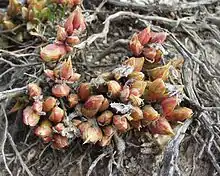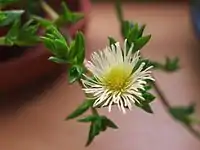| Kanna | |
|---|---|
 | |
| Scientific classification | |
| Kingdom: | Plantae |
| Clade: | Tracheophytes |
| Clade: | Angiosperms |
| Clade: | Eudicots |
| Order: | Caryophyllales |
| Family: | Aizoaceae |
| Genus: | Mesembryanthemum |
| Species: | M. tortuosum |
| Binomial name | |
| Mesembryanthemum tortuosum | |
| Synonyms[1] | |
| |
Mesembryanthemum tortuosum (many synonyms, including Sceletium tortuosum) is a succulent plant in the family Aizoaceae native to the Cape Provinces of South Africa.[1] It is known as kanna, channa, kougoed (kauwgoed/ 'kougoed', prepared from 'fermenting' M. tortuosum[2])—which literally means, 'chew(able) things' or 'something to chew'.
Eight species related to M. tortuosum have also been placed in the genus Sceletium: M. crassicaule, M. emarcidum, M. exalatum, M. expansum, M. archeri (S. rigidum), M. ladismithiense (S. strictum), M. tortuosum and M. varians.[3]
History
The plant has been used by South African pastoralists and hunter-gatherers as a mood-altering substance from prehistoric times.[4] The first known written account of the plant's use was in 1662 by Jan van Riebeeck. The traditionally prepared dried plant was often chewed and the saliva swallowed, but it has also been made into gel caps, teas and tinctures.[5] It has also been used as a snuff and smoked.[6]
Uses
M. tortuosum is traditionally used to fight stress and depression, relieve pain and alleviate hunger.[6]
M. tortuosum has been studied to alleviate excessive nocturnal barking in dogs, or meowing in cats, in pets diagnosed with dementia.[4]
Cultivation
M. tortuosum can be grown from seeds and be propagated from cuttings. Its cultivation and care are similar to cactaceae like Echinopsis. The optimal temperature is at least 16°C and it does not tolerate frost.[7]
Pharmacology
M. tortuosum contains about 1–1.5% total alkaloids.[6] A standardised ethanolic extract of dried M. tortuosum had an IC50 for SERT of 4.3 μg/ml and for PDE4 inhibition of 8.5 μg/ml.[3]
 Mesembrenol |
Mesembrine
Mesembrine is a major alkaloid present in M. tortuosum.[8] There is about 0.3% mesembrine in the roots and 0.86% in the leaves, stems, and flowers of the plant.[6]
Safety
General
Traditional and contemporary methods of preparation serve to reduce levels of potentially harmful oxalates found in M. tortuosum.[6] An analysis indicated levels of 3.6–5.1% oxalate, which falls within the median range for crop plants, just like spinach or kale.[6] It is speculated that physical crushing of the plant and the fermentation process reduce the potentially harmful effects of oxalic acid.[6] In particular, free oxalic acid is likely to complex with cell wall-associated calcium salts and precipitate as calcium oxalate when plant material is crushed.[6]
Human studies
In a study evaluating its safety, a 2:1 standardised extract consumed by healthy adults at a dose of up to 25 mg once daily over a three-month period was well tolerated, with adverse effects such as headache not occurring more than when taking a placebo.[9]
Gallery
 Flower
Flower Being sold commercially in Cape Town, South Africa. It is ground into a brown powder and ingested orally.
Being sold commercially in Cape Town, South Africa. It is ground into a brown powder and ingested orally. Seedling
Seedling
See also
References
- 1 2 3 "Mesembryanthemum tortuosum L." Plants of the World Online. Royal Botanic Gardens, Kew. Retrieved 2023-01-27.
- ↑ Smith, M. T.; Field C. R.; Crouch N. R.; Hirst, M. (1998). "The Distribution of Mesembrine Alkaloids in Selected Taxa of the Mesembryanthemaceae and their Modification in the Sceletium Derived 'Kougoed'" (PDF). Pharmaceutical Biology. 36 (3): 173–179. doi:10.1076/phbi.36.3.173.6350.
- 1 2 Harvey, A. L.; Young, L. C.; Viljoen, A. M.; Gericke, N. P. (2011). "Pharmacological Actions of the South African Medicinal and Functional Food Plant Sceletium tortuosum and its Principal Alkaloids" (PDF). Journal of Ethnopharmacology. 137 (3): 1124–1129. doi:10.1016/j.jep.2011.07.035. PMID 21798331. Archived from the original (PDF) on 2015-06-30.
- 1 2 Gericke, N.; Viljoen, A. M. (2008). "Sceletium–A Review Update". Journal of Ethnopharmacology. 119 (3): 653–663. doi:10.1016/j.jep.2008.07.043. PMID 18761074.
- ↑ Manganyi, Madira Coutlyne; Bezuidenhout, Cornelius Carlos; Regnier, Thierry; Ateba, Collins Njie (2021-04-28). "A Chewable Cure "Kanna": Biological and Pharmaceutical Properties of Sceletium tortuosum". Molecules (Basel, Switzerland). 26 (9): 2557. doi:10.3390/molecules26092557. ISSN 1420-3049. PMC 8124331. PMID 33924742.
- 1 2 3 4 5 6 7 8 Smith, M. T.; Crouch, N. R.; Gericke, N.; Hirst, M. (1996). "Psychoactive Constituents of the Genus Sceletium N.E.Br. and other Mesembryanthemaceae: A Review". Journal of Ethnopharmacology. 50 (3): 119–130. doi:10.1016/0378-8741(95)01342-3. PMID 8691846.
- ↑ "CULTIVATION: How To Grow Healthy Kanna Plants". Kanna Sceletium Tortuosum. 2016-11-14. Retrieved 2023-02-08.
- ↑ Coetzee, Dirk D.; López, Víctor; Smith, Carine (2016-01-11). "High-mesembrine Sceletium extract (Trimesemine™) is a monoamine releasing agent, rather than only a selective serotonin reuptake inhibitor". Journal of Ethnopharmacology. 177: 111–116. doi:10.1016/j.jep.2015.11.034. ISSN 0378-8741. PMID 26615766.
- ↑ Nell H, Siebert M, Chellan P, Gericke N (2013). "A randomized, double-blind, parallel-group, placebo-controlled trial of Extract Sceletium tortuosum (Zembrin) in healthy adults". Journal of Alternative and Complementary Medicine. 19 (11): 898–904. doi:10.1089/acm.2012.0185. PMID 23441963. Retrieved 2015-06-29.
Both doses of extract Sceletium tortuosum (Zembrin) (8 mg and 25 mg) were well tolerated when used by healthy human subjects once daily for 3 months.
External links
- Monograph on Sceletium tortuosum
- The past, present and possible future of kanna Video. Talk of Nigel Gericke at Ethnopharmacologic Search for Psychoactive Drugs. 2017.
Further reading
- van Wyk, Ben-Erik; van Oudtshoorn, Bosch; Gericke, Nigel (2009). Medicinal Plants of South Africa (2nd ed.). Pretoria, South Africa: Briza Publications. p. 200. ISBN 978-1-875093-37-3.


